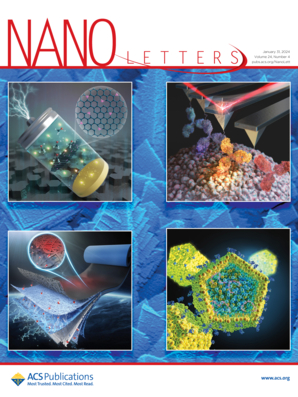非局部元表面中的高效热光切换和调制
IF 9.1
1区 材料科学
Q1 CHEMISTRY, MULTIDISCIPLINARY
引用次数: 0
摘要
非局部元表面中的高 Q 值光学共振得益于显著增强的光/物质相互作用,即使在微弱的外部刺激下也能产生强烈的响应。在这项工作中,我们利用光子晶体板(PCS)结构支持的准引导模式(QGMs)的高Q值共振来实现高效的光学切换/调制。通过移动硅板内矩形晶格中的每两列气孔,实现了实验测得 Q 因子为 ∼2200 的 QGM。在来自 532 nm 连续波泵浦激光器的小于 4.0 W/cm2 的微弱照明强度下,1550 nm 附近的 QGM 共振经历了明显的光谱偏移,调制深度超过 55%。这归因于泵浦激光在硅中的吸收引发的元表面光热加热所产生的热光学响应,而电加热方法则进一步验证了这一点。我们报告的结果展示了在非局部元表面中定制光传播的一种简单而有效的方法。本文章由计算机程序翻译,如有差异,请以英文原文为准。

Efficient Thermo-Optic Switching and Modulating in Nonlocal Metasurfaces
High-Q optical resonances in nonlocal metasurfaces, benefiting from significantly enhanced light/matter interactions, feature strong responses even under a weak external stimulus. In this work, we leverage the high-Q resonances of quasi-guided modes (QGMs) supported by a photonic crystal slab (PCS) structure to achieve efficient optical switching/modulation. The QGMs with an experimentally measured Q-factor of ∼2200 are realized by shifting every second column of air holes in a rectangular lattice within a silicon slab. At a weak illumination intensity of less than 4.0 W/cm2 from a 532 nm continuous-wave pump laser, the QGM resonance around 1550 nm experiences a pronounced spectral shift, with modulation depth exceeding 55%. This is attributed to the thermo-optic response caused by photothermal heating of the metasurface triggered by the absorption of the pump laser in silicon, which is further verified by the electrical heating approach. Our reported results showcase a simple yet effective way of tailoring light propagation in nonlocal metasurfaces.
求助全文
通过发布文献求助,成功后即可免费获取论文全文。
去求助
来源期刊

Nano Letters
工程技术-材料科学:综合
CiteScore
16.80
自引率
2.80%
发文量
1182
审稿时长
1.4 months
期刊介绍:
Nano Letters serves as a dynamic platform for promptly disseminating original results in fundamental, applied, and emerging research across all facets of nanoscience and nanotechnology. A pivotal criterion for inclusion within Nano Letters is the convergence of at least two different areas or disciplines, ensuring a rich interdisciplinary scope. The journal is dedicated to fostering exploration in diverse areas, including:
- Experimental and theoretical findings on physical, chemical, and biological phenomena at the nanoscale
- Synthesis, characterization, and processing of organic, inorganic, polymer, and hybrid nanomaterials through physical, chemical, and biological methodologies
- Modeling and simulation of synthetic, assembly, and interaction processes
- Realization of integrated nanostructures and nano-engineered devices exhibiting advanced performance
- Applications of nanoscale materials in living and environmental systems
Nano Letters is committed to advancing and showcasing groundbreaking research that intersects various domains, fostering innovation and collaboration in the ever-evolving field of nanoscience and nanotechnology.
 求助内容:
求助内容: 应助结果提醒方式:
应助结果提醒方式:


